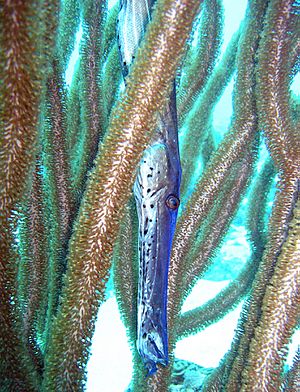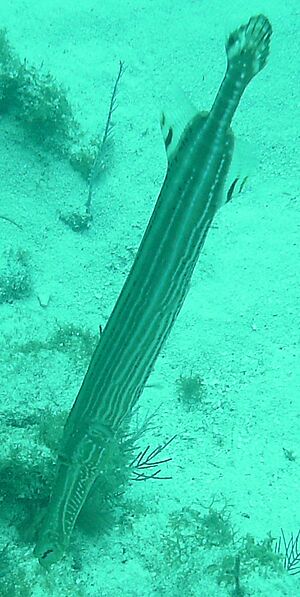West Atlantic trumpetfish facts for kids
Quick facts for kids West Atlantic trumpetfish |
|
|---|---|
 |
|
| Conservation status | |
| Scientific classification | |
| Synonyms | |
|
The West Atlantic trumpetfish (scientific name: Aulostomus maculatus) is a long, thin fish with a mouth that points upwards. It often swims straight up and down. This helps it hide among tall corals like sea rods and pipe sponges.
Description
The West Atlantic trumpetfish is related to cornetfish. These fish can grow to be over 36 inches (91 cm) long. Their bodies are very long and flat from side to side. They have a flat head with a small mouth at the end of a long, tube-shaped snout.
You can see a small whisker-like barbel on their chin. Their dorsal fin (top fin) and anal fin (bottom fin) are located towards the back of their body. The dorsal fin has 8 to 12 separate spines in front of it. The caudal fin (tail fin) is rounded.
Trumpetfish are usually mottled brown or reddish-brown. They have irregular black or brown spots. They can also be blue-gray, bright yellow, or green. These fish can change their color to blend in with their surroundings. They often have silvery stripes on their head and sides. There is usually a black bar or spot at the base of their dorsal and anal fins. They might also have one or two spots on their tail.
These fish can grow up to 100 centimetres (39 in) long. However, they are more commonly around 60 centimetres (24 in) in length.
Distribution
The West Atlantic trumpetfish lives in the warm, tropical waters of the western Atlantic Ocean. You can find them from Florida all the way down to Brazil. This includes the Caribbean Sea and the Gulf of Mexico.
Habitat and biology
Trumpetfish are predators that mainly eat other fish. They are ambush hunters, meaning they wait for their prey. They often hide among groups of large plant-eating fish. They follow these fish until they are close enough to strike at their prey.
They also like to hang vertically among gorgonian corals. Sometimes, they just drift with the ocean currents. When a small fish or shrimp swims underneath them, they quickly suck it into their mouth. Their mouth has stretchy tissues that let it open as wide as their body. This sudden opening creates a vacuum, pulling the prey right in.
Trumpetfish eat many kinds of small fish and shrimp. Some of their prey include ocean surgeonfish, blue chromis, and bluehead wrasse. They usually hunt alone. However, they sometimes join schools of striped parrotfish. This helps them avoid attacks from other fish like the dusky damselfish. When they are with parrotfish, they can catch more food than when they hunt alone.
Human use
The West Atlantic trumpetfish is sometimes caught for the aquarium trade. This means people keep them as pets in fish tanks. They are also caught by fishermen using nets and traps. However, they are not a very important fish for commercial fishing.
Conservation
The places where trumpetfish live, like coral reefs and seagrass beds, are shrinking. This is a threat to the species, especially in the Caribbean. Also, invasive lionfish, like Pterois volitans, eat smaller trumpetfish.
There are no special plans just to protect trumpetfish. But they live in many protected marine areas. Even though their habitats are declining, trumpetfish are strong fish. They can live in other places like rocky reefs. Because they live in such a wide area and can adapt, the IUCN lists them as a species of Least Concern. This means they are not currently at high risk of disappearing.




